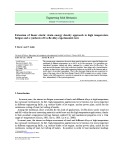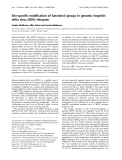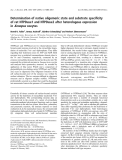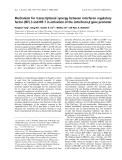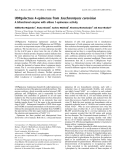
Extensions to c
-
The present paper summaries the results from uniaxial-tension stress-controlled fatigue tests performed at different temperatures up to 650°C on Cu-Be specimens. Two geometries are considered: hourglass shaped and plates weakened by a central hole (Cu-Be alloy).
 6p
6p  tohitohi
tohitohi
 19-05-2020
19-05-2020
 9
9
 1
1
 Download
Download
-
The human b-globin gene locus is the subject of intense study, and over the past two decades a wealth of information has accumulated on how tissue-specific and stage-specific expression of its genes is achieved. The data are extensive and it would be difficult, if not impossible, to formulate a comprehensive model integrating every aspect of what is currently known. In this review, we introduce the fundamental characteristics of globin locus regulation as well as questions on which much of the current research is predicated.
 11p
11p  system191
system191
 01-06-2013
01-06-2013
 47
47
 4
4
 Download
Download
-
The case of homologous monomeric c-type and oligomeric b-type crystallins has been described and analyzed in evolutionary terms. Data and hypotheses from molecular genetics and structural investigations converge and suggest a novel three-phase model for the evolutionary history of crystallin-type proteins. In the divergent cascades of monomeric and oligomeric crystallins, a pivotal role was played by alterations in the gene segments encoding the C-terminal extensions and the intermotif or interdomain linker peptides.
 9p
9p  system191
system191
 01-06-2013
01-06-2013
 41
41
 4
4
 Download
Download
-
There is extensive evidence that FcR c-chain couples to the collagen receptor glycoprotein VI (GPVI) and becomes phosphorylated on tyrosines upon receptor cross-linking. However, it is not established whether this receptor complex is sufficient to initiate the signalling cascade. We transfected GPVI and the FcR c-chain into the human erythroleukaemia cell line K562, which lacks detectable expression of GPVI and the FcR c-chain. The results show that GPVI is unable to signal when expressed alone, despite its surface expression, upon stimulation with the snake C-type lectin, convulxin....
 10p
10p  system191
system191
 01-06-2013
01-06-2013
 35
35
 3
3
 Download
Download
-
The decoy approach against nuclear factor kB (NF-kB) is a useful tool to alter NF-kB dependent gene expression using synthetic oligonucleotides (ODNs) carrying NF-kB specific cis-elements. Unfortunately, ODNs are not stable and need to be extensively modified to be used in vivo or ex vivo. We have previously evaluated the possible use of peptide nucleic acids (PNAs) as decoy molecules. The backbone of PNAs is composed of N-(2-aminoethyl)glycine units, rendering these molecules resistant to both nucleases and proteases.
 10p
10p  system191
system191
 01-06-2013
01-06-2013
 42
42
 4
4
 Download
Download
-
Cytochrome c is widely distributed in bacterial species, from mesophiles to thermophiles, and is one of the best-characterized redox proteins in terms of biogenesis, folding, structure, function, and evolution. Experimental molecular biology techniques (gene cloning and expression) have become applicable to cytochrome c, enabling its engineering and manipulation. Heterologous expression systems for cytochromes c in bacteria, for use in mutagenesis studies, have been established by extensive investigation of the biological process by which the functional structure is formed. ...
 7p
7p  research12
research12
 01-06-2013
01-06-2013
 32
32
 3
3
 Download
Download
-
Bovineb-lactoglobulin was hydrolyzed with trypsin or chymotrypsin in the course of heat treatment at 55, 60 and 65°C at neutral pH. At these temperaturesb-lactoglobulin undergoes signi®cant but reversible structural changes. In the conditions used in the present study,b-lactoglobulinwas virtually insensitive to proteolysis by either enzyme at room temperature, but underwent extensive proteolysis when either proteasewas present during the heat treatment.
 11p
11p  research12
research12
 29-04-2013
29-04-2013
 33
33
 3
3
 Download
Download
-
Human hepatitis delta (HDV) ribozyme is one of small ribozymes, such as hammerhead and hairpin ribozymes, etc. Its secondary structure shows pseudoknot structure com-posed of four stems (I to IV) and three single-stranded regions (SSrA, -B and -C). The 3D structure of 3¢-cleaved product of genomic HDV ribozyme provided extensive information about tertiary hydrogen bonding interactions between nucleotide bases, phosphate oxygens and 2¢OHs including new stem structure P1.1.
 12p
12p  tumor12
tumor12
 22-04-2013
22-04-2013
 38
38
 3
3
 Download
Download
-
NTPDase1 and NTPDase2 are two related plasma mem-brane-located enzymes involved in the extracellular degra-dation of nucleoside 5¢-tri- and -diphosphates. They differ regarding their hydrolysis ratios for ATP and ADP. Both enzymes have a predicted transmembrane domain close to the N- and C-terminus, respectively, connected by an extensive extracellular domain that carries the active site.We expressed the rat-derived enzymes inXenopus laevisoocytes and analyzed their quarternary structure.
 8p
8p  fptmusic
fptmusic
 16-04-2013
16-04-2013
 32
32
 5
5
 Download
Download
-
The small heat shock proteins function as molecular chaperones, an activ-ity often requiring reversible oligomerization and which protects against irreversible protein denaturation. An abundantly produced small heat shock protein termed p26 is thought to contribute to the remarkable stress resistance exhibited by encysted embryos of the crustacean,Artemia francis-cana. Three novel sequence motifs termed G, R and TS were individually deleted from p26 by site-directed mutagenesis.
 14p
14p  fptmusic
fptmusic
 12-04-2013
12-04-2013
 44
44
 4
4
 Download
Download
-
Trypanosoma cruzi, the parasitic protozoan that causes Chagas disease, contains a major cysteine proteinase, cruzipain. This lysosomal enzyme bears an unusual C-terminal extension that contains a number of post-translational modifications, and most antibodies in natural and experimen-tal infections are directed against it. In this report we took advantage of UV-MALDI-TOF mass spectrometry in conjunction with peptide N-gly-cosidase F deglycosylation and high performance anion exchange chroma-tography analysis to address the structure of the N-linked oligosaccharides present in this domain. ...
 13p
13p  fptmusic
fptmusic
 11-04-2013
11-04-2013
 42
42
 2
2
 Download
Download
-
In the majority of hypophosphatasia patients, reductions in the serum lev-els of alkaline phosphatase activity are caused by various missense muta-tions in the tissue-nonspecific alkaline phosphatase (TNSALP) gene. A unique frame-shift mutation due to a deletion of T at cDNA number 1559 [TNSALP (1559delT)] has been reported only in Japanese patients with high allele frequency.
 14p
14p  awards
awards
 06-04-2013
06-04-2013
 43
43
 4
4
 Download
Download
-
Phosphorylase kinase (PhK) is a large hexadecameric enzyme consisting of four copies of four subunits: (abcd)4. An intrinsic calmodulin (CaM, the d subunit) binds directly to the cprotein kinase chain. The interaction site of CaM onchas been localized to a C-terminal extension of the kinase domain. Two 25-mer peptides derived from this region, PhK5 and PhK13, were identified previously as potential CaM-binding sites.
 12p
12p  awards
awards
 06-04-2013
06-04-2013
 37
37
 4
4
 Download
Download
-
The aromatic hydrocarbon receptor (AhR)-dependent pathway involved in 2,3,7,8-tetrachlorodibenzo-p-dioxin (TCDD)-induced immunotoxicity has been studied extensively, but the AhR-independent molecular mechan-ism has not. In previous studies we found that the AhR is not expressed in L-MAT, a human lymphoblastic T-cell line. In this report, we provide the following evidence that the protein kinase C (PKC)hactivity is func-tionally involved in the AhR-independent signal transduction mechanism that participates in the TCDD-induced L-MAT cell apoptosis....
 13p
13p  awards
awards
 05-04-2013
05-04-2013
 29
29
 2
2
 Download
Download
-
Theinterferon-bpromoter has been studied extensively as a model system for combinatorial transcriptional regulation. Invirus-infectedcells the transcription factorsATF-2, c-Jun, interferon regulatory factor (IRF)-3, IRF-7andNF-jB, and the coactivators p300/CBP play critical roles in the activa-tion of this and other promoters. It remains unclear, how-ever, why most other combinations of AP-1, IRF and Rel proteins fail to activate theinterferon-bgene. Here we have explored how different IRFs may cooperate with other fac-tors to activate transcription....
 11p
11p  awards
awards
 05-04-2013
05-04-2013
 40
40
 4
4
 Download
Download
-
UDPgalactose 4-epimerase (epimerase) catalyzes the reversible conversion between UDPgalactose and UDPglu-cose and is an important enzyme ofthe galactose metabolic pathway. TheSaccharomyces cerevisiaeepimerase encoded by theGAL10gene is about twice the size ofeither the bacterial or human protein.
 7p
7p  dell39
dell39
 03-04-2013
03-04-2013
 30
30
 4
4
 Download
Download
-
G-protein-coupled receptor kinases (GRK) are known to phosphorylate agonist-occupied G-protein-coupled receptors. We expressed and function-ally characterized mouse GRK6 proteins encoded by four distinct mRNAs generated by alternative RNA splicing from a single gene, mGRK6-A to mGRK6-D.
 13p
13p  dell39
dell39
 27-03-2013
27-03-2013
 41
41
 4
4
 Download
Download
-
The 3C-like protease of the severe acute respiratory syndrome (SARS) cor-onavirus has a C-terminal extra domain in addition to the chymotrypsin-fold adopted by piconavirus 3C proteases hosting the complete catalytic machinery. Previously we identified the extra domain to be involved in enzyme dimerization which has been considered essential for the catalytic activity.
 11p
11p  inspiron33
inspiron33
 26-03-2013
26-03-2013
 41
41
 4
4
 Download
Download
-
Here, we report for the first time quinol peroxidase (QPO), an enzyme that uses ubiquinol-1 as an electron donor for the reduction of H2O2 to water. We purified QPO to 90% purity from the membrane fraction ofActino-bacillus actinomycetemcomitans. QPO is a 53.6-kDa protein that contains three heme c molecules. Theqpogene was predicted to encode a putative bacterial cytochromec peroxidase with N-terminal extensions containing an additional potential hemec-binding motif.
 14p
14p  galaxyss3
galaxyss3
 21-03-2013
21-03-2013
 34
34
 3
3
 Download
Download
-
Cell survival depends not only on the ability to repair damaged DNA but also on the capability to perform DNA replication on unrepaired or imperfect templates. Crucial to this process are specialized DNA polym-erases belonging to the Y family. These enzymes share a similar catalytic fold in their N-terminal region, and most of them have a less-well-con-served C-terminus which is not required for catalytic activity.
 11p
11p  galaxyss3
galaxyss3
 19-03-2013
19-03-2013
 36
36
 3
3
 Download
Download
CHỦ ĐỀ BẠN MUỐN TÌM









